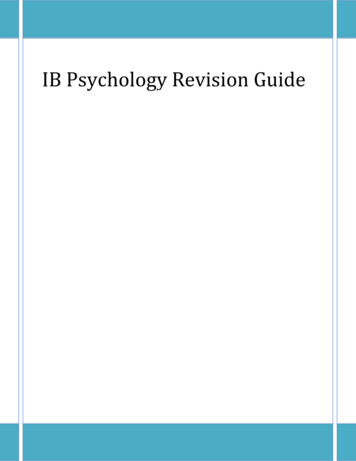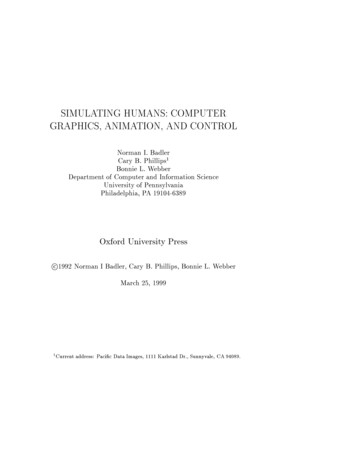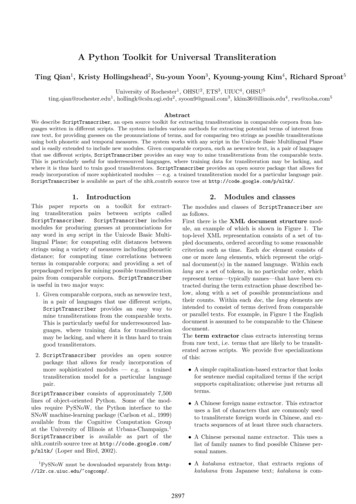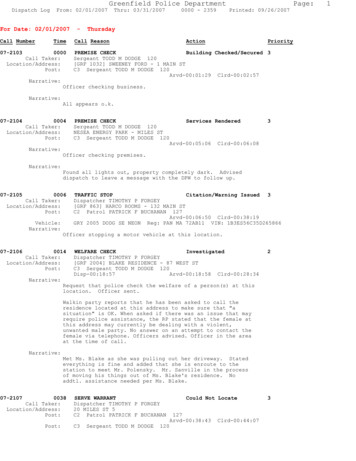
Transcription
IB Psychology Revision GuideIB Psychology Revision GuideCore: Paper 1 - First Exams 2011Written by: Chris Ting 13H3/23/11
DisclaimerThank you for purchasing or using this guide for your revision purposes. I hope you find thisguide useful and I hope it makes your Psychology revision a bit easier.This guide covers the core area of the Psychology syllabus, which are the three levels of analysis.For the research methods and ethics questions, details and a general evaluation of the researchmethods used in each level are provided and also relevant ethical concerns. These questionscan be answered by using the research provided in the guide.Please do not rely solely on this revision guide for your tests and exams. This guide is meantto be used in conjunction with your own notes and those that are provided in class. If you failbecause you only used this guide, it is not my fault. There is usually more research thanrequired provided in this guide and it is not a definite way to answer it.Thank you and good luck.Chris Ting 13H25/03/2011
Table of ContentsBiological Level of Analysis . 1General Learning Outcomes . 1Physiology and Behavior . 6Genetics and behavior . 31Cognitive Level of Analysis . 41General Learning Outcomes . 41Cognitive processes . 44Cognition and emotion . 66Sociocultural Level of Analysis . 74General learning outcomes . 74Sociocultural cognition . 78Social norms . 88Cultural norms . 100Research Methods and Ethics . 104
Biological Level of AnalysisBiological Level of AnalysisGeneral Learning OutcomesSyllabus Question: Outline principles that define the biological level of analysis.The three principles that define the biological level of analysis are:I.Emotions and behavior are products of the anatomy and physiology of the nervous andendocrine systems.Patterns of behavior can be inherited.Animal research may inform our understanding of human behavior.II.III.IV.Syllabus Question: Explain how principles that define the biological level of analysis may bedemonstrated in research.Principle 1: Emotions and behavior are products of the anatomy and physiology of the nervous andendocrine systems.I.Suggests that behavior is genetically inherited. The patterns of behavior we see today aretheorized to have been of evolutionary benefits.a. What is inherited may be a predisposition for a certain behavior that requireparticular environmental stimuli before behavior will manifestResearch that demonstrates this principle are:What was the study on?Aim of the experimentConditions of the experimentHeston (1996)An adoption study, which assume that if offspring are separatedfrom their biological parents we can conclude that any physical andbehavioral similarities between parent and child are caused bygenetic factorsStudy was too see whether schizophrenia is genetic or notIf genetic, adoption would not affect number of children laterdiagnosed with schizophrenia but due to biological inheritance ahigher incident of schizophrenia would be expected among adoptedchildren of schizophrenic mothers than those without schizophrenicmothersIf nurture, incidence rate would be approximately same as otheradopteesResultsIncident of schizophrenia in general population is about 1% and wassimilar for those who were adopted with no family history ofPage 1
Biological Level of AnalysisConclusionLink to syllabus questionWhat is this study about?AimConditionsResultsConclusionLink to questionschizophreniaOver 10% of adopted children with family history of schizophreniawere later diagnosed with itResearch shows that schizophrenia has a strong genetic componentThis research demonstrates that schizophrenia can be inherited andtherefore shows that patterns of behavior can be inherited.Bailey and Pillard (1991)Studied monozygotic and dizygotic twins and measured how often whenone twin was homosexual the other was also homosexualTo whether homosexuality can be caused by genetics.Tested MZ and DZ twinsThere is a difference in concordance for homosexualityDZ twins had a concordance rate of 22%MZ twins had a concordance rate of 52%Results suggest that there environmental factors to explain why MZ twinsdidn’t reach 100% and that there is a strong genetic factor as to why MZtwins had double the concordance rate of homosexuality than DZResearch demonstrates the principle by showing the homosexuality can beinherited and can be genetic.Principle 2: Animal research may inform our understanding of human behavior.I.Based on idea that humans and the many different species of animals or different because ofevolution and therefore suggests we are fundamentally the same thus it is valid to try to makepredictions on human behavior based on animal research.a. The mechanisms that underlie behavior are the core similarity we share with animalsResearch that demonstrates this principle are:What was this study about?AimConditionsMartinez and Kesner (1991)To test the effects of the neurotransmitter acetylcholine on memoryformation of mazes in rats.To see whether acetylcholine plays a role in memory formationRats were trained to go through a maze and received food at the end.Once rats could do this experimenters injected:One group of rats with scopolamine which blocks acetylcholine sites thusdecreasing available acetylcholineA second group of rats with physostigmine, which blocks production ofcholinesterase, which removes acetylcholine from synapse and returnneuron to resting stateResultsThe control group was injected nothing.Rats injected with scopolamine were slower at finding way around mazePage 2
Biological Level of Analysisand made more errors than compared to other two groupsPhysostigmine group ran through maze quicker and made less errorsConclusionLink to questionWhat is this research about?AimConditionsConcluded that acetylcholine played an important role in a memory formazeDemonstrates how conduction research on animals allows us to informour understanding of behavior.Matsuzawa (2007)Tested spatial memory in humans and chimpanzeesTo compare the differences of spatial memory between youngchimpanzees and humansResearchers took three pairs of chimps and taught them to recognizethe numbers 1-9 on a computer screenBoth the chimps and human participants were seated at a computerterminal, where the numbers flashed up very briefly on a touch-screenmonitor in a random sequenceThe numbers were then replaced with blank squares and the participanthad to remember which number appeared in which location and totough the squares in the appropriate sequenceHuman participants made many errors and accuracy decreased thenumbers were replaced with blank squares more quicklyResultsChimpanzees showed remarkable memory for spatial distribution ofnumbers, with no difference when numbers were shown for shorterdurationsConclusionLink to questionConcluded that the memory of chimpanzees was a necessary adaptionto survive and humans didn’t need it anymoreAn example of evolution and shows us how studying animals allowed usto see differences in aspects of memory between chimpanzees andhumansPrinciple 3: Emotions and behavior are products of the anatomy and physiology of the nervous andendocrine systemsI.II.Suggests that all observable behavior, as well as internal mental activity of an individual can betraced back to physiological eventsLinks have between found between psychological and physiological activity in the effects ofneurotransmitters, hormones and brain localization.Research that demonstrate this principle are:Page 3
Biological Level of AnalysisWhat was this study about?AimConditionsMartinez and Kesner (1991)To test the effects of the neurotransmitter acetylcholine on memoryformation of mazes in rats.To see whether acetylcholine plays a role in memory formationRats were trained to go through a maze and received food at the end.Once rats could do this experimenters injected:One group of rats with scopolamine which blocks acetylcholine sites thusdecreasing available acetylcholineA second group of rats with physostigmine, which blocks production ofcholinesterase, which removes acetylcholine from synapse and returnneuron to resting stateResultsThe control group was injected nothing.Rats injected with scopolamine were slower at finding way around mazeand made more errors than compared to other two groupsPhysostigmine group ran through maze quicker and made less errorsConclusionLink to questionWhat is this study about?AimMethodConcluded that acetylcholine played an important role in a memory formazeDemonstrates the effects of neurotransmitters and therefore howphysiological aspects of our body influence the way we operate.Schachter and Singer (1962)To see the effects of placebos and see the different effects of hormoneswhen in different environmental contextsProposed that adrenaline causes emotion but the nature of the emotionwas dependent on contextual factorsThey recruited volunteers to receive a vitamin injection and informedthem that they would be participating in vision experiments. None of the184 male participants received a vitamin injection. Three groups receivedadrenaline injection and a fourth group received a placebo injection. Thethree groups receiving the adrenaline injection were either given corrector incorrect information about the effects of the injectionThe participants were placed in one of the two conditions. Euphoria, aconfederate of the experimenters encourages the participant to join ingames. Anger, a confederate fills out a mock questionnaire with theparticipants but gets increasingly outraged by personal nature ofquestionsResultsExperimenters use observational data based on structured observationsof participants in each condition and asked them to complete a form thatassessed their mood in terms of happiness and angerIn the euphoria condition, the groups who received an adrenalinePage 4
Biological Level of AnalysisConclusionLink to questioninjection with incorrect information about effects showed more euphoricand happy behaviorConclude that emotion occurs by cognitive labelingShows how a physiological aspect such as hormones can affect ourbehavior.Page 5
Biological Level of AnalysisPhysiology and BehaviorI.Localization refers to the idea that behavior, emotions and thoughts originate in the brain inspecific locationsa. Left hemisphere:i. Dormant for language, writing, logical, analytic and calculating thoughtb. Right hemispherei. Dormant for visuospatial tasks such as drawing, face recognition, visuospatialproblems, synthetic and holistic thoughtWhat was this study about?AimMethodResultsSperry (1968)The effects of brain localization on a patient who underwent split brainsurgery .Presented studies investigating behavioral, neurological andpsychological consequences of split-brain surgery resulting indisconnected hemispheres.Studies were used to suggest that each hemisphere: Has slightlydifferent functions, possesses an independent stream of consciousawareness, has its own set of memories inaccessible to the otherA natural experiment was conducted on patients who underwent splitbrain surgery. The capabilities of each hemisphere was tested bypresenting visual information, at fast speeds so patients eyes can’trefocus, to either left or right visual field when patient was lookingstraight ahead. Information presented to left visual field will be receivedby right hemispherePresenting tactile information to either left or right hand behind ascreen. Tactile information from objects felt by right hand will bereceived by left hemisphereVisual stimuli presented in one visual field at a timeII.Objects shown once to a visual field are only recognized ifpresented again in same visual fieldIII.Objects presented in right visuals, received by left hemisphere,can be named verbally and in writingIV.Objects presented in left field, received by right hemisphere, canot be named verbally or in writing but can be identifiedthrough pointinga. Suggests two hemispheres have different abilities andfunctions and therefore shows localizationDifferent visual stimuli presented simultaneously to different visualfieldsV.If different visual stimuli are presented simultaneously todifferent visual fields and subject is asked to draw with lefthand what was seen, subject will draw the stimuli from leftvisual, if asked what left hand has drawn, subject replies withPage 6
Biological Level of Analysiswhat was seen in right visual fieldVI.If two related words are simultaneously presented to differentvisual fields, left hand will select what was seen by left visualfield amongst objects, the right hand will write what was seenin right visual field without being influencing by what was seenby left visual fielda. Left hand is for what was seen by left visual fieldb. Right hand is for what was seen by right visual fieldc. What was seen by left visual field is processed by righthemisphered. What was seen by right visual field will be processed byleft hemisphereTactile stimuli presented to different handsVII.An object felt by left hand can be recognized by left hand againbut cannot be named or recognized by right hand amongstobjectsConclusionCertain functions and behaviors are suggested to be localized to certainhemispheres of the brain.Page 7
Biological Level of AnalysisSyllabus Question: Using or one more examples, explain the effects of neurotransmission on humanbehavior.I.When your brain is stimulated by your environment, it reacts by sending electrical impulsesthrough your body to react. The method these impulses are sent is neurotransmission, whenelectrical impulses travel down the axon it releases neurotransmitters which cross the synapsejunction. Neurotransmitters are chemical messengers that send message from one neuron toanotherII.Examples of neurotransmitters Results in muscle contraction and a role in the development of memory in thehippocampusResults in voluntary movement, learning and feelings of pleasureResults in arousal, alertness and stimulation of sympathetic nervous systemResults in sleep, arousal levels and emotionResearch that demonstrates the effects of neurotransmission on behavior include:What was this study about?AimConditionsMartinez and Kesner (1991)To test the effects of the neurotransmitter acetylcholine on memoryformation of mazes in rats.To see whether acetylcholine plays a role in memory formationRats were trained to go through a maze and received food at the end.Once rats could do this experimenters injected:One group of rats with scopolamine which blocks acetylcholine sitesthus decreasing available acetylcholineA second group of rats with physostigmine, which blocks production ofcholinesterase, which removes acetylcholine from synapse and returnneuron to resting stateResultsConclusionLink to questionThe control group was injected nothing.Rats injected with scopolamine were slower at finding way aroundmaze and made more errors than compared to other two groupsPhysostigmine group ran through maze quicker and made less errorsConcluded that acetylcholine played an important role in a memory formazeDemonstrates the effects of neurotransmitters on human behavior andfunctions.Page 8
Biological Level of AnalysisWhat was the study about?AimMethodResultsConclusionKasamatsu and Hirai (1999)Carried out an experiment to see how sensory deprivation affects thebrainTo see how sensory deprivation affects the brain.Researchers studied a group of Buddhist monks who went on a 72-hourpilgrimage to a mountain in Japan. During their stay, they did not speak,consume food, and were exposed to cold weather. After 48 hours theybegan to have hallucinations, researchers took blood samples before themonks ascended the mountain and immediately after monks reportedhallucinationsFound that serotonin levels had increased in monk’s brains. Higher levelof serotonin activated the hypothalamus and frontal cortex resulting inthe hallucinations.Researchers concluded that sensory deprivation triggered release ofserotonin.Page 9
Biological Level of AnalysisSyllabus Question: Using one or more examples, explain functions of 2 or more hormones in humanbehavior.I.Hormones are chemical that affect behavior. They are produced by glands that make up theendocrine system. Hormones enter directly into the bloodstream and therefore take longer toproduce changes in behavior than neurotransmittersII.Examples of hormones erone and OestrogenFight or flight response, arousalArousal, stress hormone, memoryRegulation of sleepMother-child attachmentDevelopment, emotionResearch that demonstrates the functions of hormones in human behavior include:What is this study about?AimMethodSchachter and Singer (1962)To see the effects of placebos and see the different effects of hormoneswhen in different environmental contextsProposed that adrenaline causes emotion but the nature of the emotionwas dependent on contextual factorsThey recruited volunteers to receive a vitamin injection and informed themthat they would be participating in vision experiments. None of the 184male participants received a vitamin injection. Three groups receivedadrenaline injection and a fourth group received a placebo injection. Thethree groups receiving the adrenaline injection were either given correct orincorrect information about the effects of the injectionThe participants were placed in one of the two conditions. Euphoria, aconfederate of the experimenters encourages the participant to join ingames. Anger, a confederate fills out a mock questionnaire with theparticipants but gets increasingly outraged by personal nature of questionsResultsConclusionLink to questionExperimenters use observational data based on structured observations ofparticipants in each condition and asked them to complete a form thatassessed their mood in terms of happiness and angerIn the euphoria condition, the groups who received an adrenaline injectionwith incorrect information about effects showed more euphoric and happybehaviorConclude that emotion occurs by cognitive labelingShows how a physiological aspect such as hormones can affect ourbehavior.Page 10
Biological Level of AnalysisWhat was this study about?AimMethodMorhenn et al. (2008)To test the effects of massaging on human behavior.To see if how massaging affect behavior.Randomly assigned 96 students to three groups, massage and trust, restand trust and massage only.Massage conditions consisted of 15 minute Swedish that were shown toincrease oxytocin levels I many peopleRest condition required participants to rest for the same amount oftime in same roomParticipants then played a trust game that asked them to make adecision about how much money to give to another participant,knowing the money would be tripled and possibility that the otherparticipant might share the profit . Sending large amounts of moneywas taken to indicate trustResultsBlood samples were taken to measure oxytocin levels, once at thebeginning of their participation and again close to their decision in thesame.Massage only group showed no significant change in oxytocin levelsParticipants in the massage and trust group who made the decisionabout sending money sent an average slightly higher than the restwithout massage group. But the amount the receiver send back to thedecision maker was significantly differentConclusionFound a positive correlation in participants who were sent money andthe change in their oxytocin level, according to whether they hadreceived a massage or simply restedConcluded that oxytocin levels helped people display trust towardsstrangers and oxytocin levels are able to predict the amount of sacrificeparticipants make in a trust game.Suggests oxytocin’s effect of on behavior is to increase generosity andcooperation among adultsPage 11
Biological Level of AnalysisSyllabus Question: Discuss two effects of the environment on physiological processes.I.Effects of the environment include and the relationship between light and melatonin and thesleep-wake cycle. There is a relationship between Light and melatonin secretion leading toSeasonal affective disorder.II.Melatonin is a hormone with a role in the cycle of sleep and is secreted from the pineal gland.Gland secretes melatonin due to changes in light. Research has shown Seasonal AffectiveDisorder (SAD) is related to seasonal variations in the production of melatonin .Melatonin isproduced primarily at night so more is produced during dark winter monthsResearch that melatonin and light play a role in seasonal affective disorder include:What did the study show?ConclusionWhat did the study show?ConclusionWhat was this study about?AimMethodTerman (1988)Found that nearly 10% of those living in NewHampshire (northern part of USA) suffered fromSAD compared to 2% in FloridaSuggests melatonin is involved as northernlatitudes get longer nights than southern latitudesLam et al. (2000)Found that phototherapy has been found toreduce or eliminate depressionPhototherapy involves exposing sufferers to 2hours of intense light shortly after they wake upin the morningSuggests light and melatonin plays a role in SADas light inhibits the secretion of melatonin andexposing to light reduces depression which islinked to melatonin.L. Rosen et al. (1989)Extended Terman (1988)’s research, who surveyed New Yorkers andfound that severity of sadness in a sample of New Yorkers was worsefor those interviewed in winter rather than summer, by comparesymptomatic seasonal changes in mood and behavior at four differentlatitudesTo compare the severity of sadness between those living in differentlatitudes.1671 men and women completed and returned a Seasonal PatternAssessment Questionnaire (SAPQ) with an almost male to female ratio.Questionnaire asked for information about time of year subjects feltbest and worse. Degree of change in mood and behavior according toseason and factors such as sleep patterns, weight gain, energy levelPage 12
Biological Level of Analysisand moodResultsResponses were scored 0-24 with 10 being required to suggest winterSADGreatest seasonal mood variation was reported in New York, least inFloridaVariations in sleep patterns was highest in New Hampshire and NewYork and lowest in FloridaAs age of respondent increased, levels of seasonal mood variationdecreasedOverall, approximately 40% of respondents felt worst in winter monthsOnly 25% of those in Florida felt there was no seasonal variation onmood compared to 50.7% of those in New YorkSufferers of SAD were found to be higher in northern latitudes thansouthernMore women suffered SAD than menResults show that SAD exists and may be to due light and lts correspond with other studiesQuestions related to winter depression may havetriggered negative memories in someAddresses geographical locations at four latitudes respondents and affected their mood at time ofand relationship to SAD and gender and agequestionnaireConclusionOlder participants may be more susceptible toforgetting negative experience and moods relatedto season and therefore could have affectedresponsesQuestionnaire was mailed to sample, responserate was not highSample size does not represent generalpopulationQuestionnaire may have attracted those who mayhave no had experienced of seasonal variations inmoodFactors such as locations, cost of living,Page 13
Biological Level of Analysisemployment, leisure facilities, age of sample mayhave affected responses gainedResearch that suggest that melatonin may not play a role in seasonal affective disorder include:What was this study about?MethodResultsConclusionWhat was this study about?MethodResultsLam et al. (1998)Examined whether there are genetic links between SAD andpersonality.Gave 163 MZ twins and 134 DZ twins questionnaires measuring levelsof SAD and levels of personalityResults suggest that correlations found between SAD scores andsome personality scores can be attributed to geneticsResults suggest that correlations found between SAD scores andsome personality scores can be attributed to geneticsSchuller et al. (1996)Investigated the personalities of a group of SADsufferers and compare them to people who alsosuffered depression, but not related to seasonsParticipants were all out patients of a clinic inCanada. 100 participants were assessed during anepisode of depression. 43 patients were classifiedas suffered SAD. 57 were classified as nonseasonally depressed. All participants werediagnosed as having a major depressive episodeWere given a personality test called NEO-PI thattests: Neuroticism (Anxiety and moodiness),Extroversion (Sociability and impulsiveness),Openness, Agreeableness, ConscientiousnessResults showed there was a substantial differencein scores of the two groups on openness scale andSAD group scores consistently higher than thenon-seasonal group.SAD group emerged as considerably more openthat other depressed peopleConclusionResearchers suggest that a important factor inSAD may be personality type and that certainpersonalities react strongly to SAD and amplifiesthe normal depressing nature of winterPage 14
Biological Level of AnalysisI.The environment has effects on our biological rhythms, biological rhythms are periodicfluctuations in physiological functioning.Types of biological rhythms include:Circadian rhythmRepeated every 24 hours and is an example of thesleep-wake cycleShorter than 24 hours, an example of this is thatit occurs within sleepLasts longer than 24 hours such as the menstrualcycleRepeated every year, an example is hibernation inanimalsUltradian rhythmInfradian rhythmCircacannual rhythmsTwo factors control biological rhythms.Endogenous factors are our internal bodily mechanisms. An example is Michael Sifre (1975) a Frenchgeologist who spent 7 months in an underground cave with no cues at all to time. His sleep-wake cyclewas fairly irregular at first but eventually settled into 25 hoursExogenous factors are the environment, such as temperature or light. The most important external cuefor the sleep wake cycle is presence of light. Sunlight readjusts the cycle and is referred to as a zeitegber.Aschoff (1979) showed that many species of animals that were maintained in constant darkness willreset their internal clocks with a brief flash of light.What was the study about?MethodResultsWhat was the study about?MethodResultsRussell et al. (1980)Investigated zeitgebers and the regulation of the menstrual cycleCollected daily samples of women’s sweat and placed it on the upperlips of a group of female participantsThe menstrual cycle of the donors and recipients were synchronized,indicating that pheromones act as a zeitgeber for the menstrual cycleWilkinson (1968)To test the effects of temperature on ourphysiological functioning.The low body temperature point in our daily cycleis called the “dead spot” and is when peopleperform badly no matter what they are doing andreport that they would prefer to be asleepTested Navy recruits on vigilance, arithmetic andother criteria after various schedules of sleep andsleep lossTests showed that there was no loss of ability onshort tests conducted on a highly motivatedPage 15
Biological Level of Analysissleep-deprived personIf individual had spent a full 8-10 hours doingvarious tasks requiring very astute observation,then deterioration was apparentPeak performance coincided with highest bodytemperature and poor performance with lowtemperatureOther effects of the environment that can affect our physiological function include shift work. Shift workusually involved three 8-hour working periods rotating anti clockwise or a phase advance schedulewhich goes from night to evening to day shift instead of a phase delay which goes from night to day toevening. Phase delay is the best order of shift rotation.Research has shown that such shift rotations can cause internal desynchronization. Long termdisorientation, stress, insomnia, exhaustion and negative effects on reaction speed, co-ordination skills,attention and problem solving.Phase advance schedule:III.IV.V.Creates a mismatch or desynchronization between body rhythms of arousal and zeitgebers ofactivity levelsDon’t allow enough adjustment time for body rhythms to catch up with new activity levelsDelay the catching up of body rhythms by shortening rather than lengthening daysResearch on the effects of shift work includes:What was the study about?MethodCzeisler et al. (1982)Experimented to see whether the negativeeffects of shift work patterns can be reduced byusing research on biological clocksParticipants were all men, aged 19-68, andworked at an industrial plant following a phaseadvance schedule and were split into threegroups:Control group consisted of 68 men who didn’twork shifts but did comparable
IB Psychology Revision Guide IB Psychology Revision Guide Core: Paper 1 - First Exams 2011 Written by: Chris Ting 13H 3/23/11 . . This guide covers the core area of the Psychology syllabus, which are the three levels of analysis. For the research methods and ethics questions, details and a general evaluation of the research .










